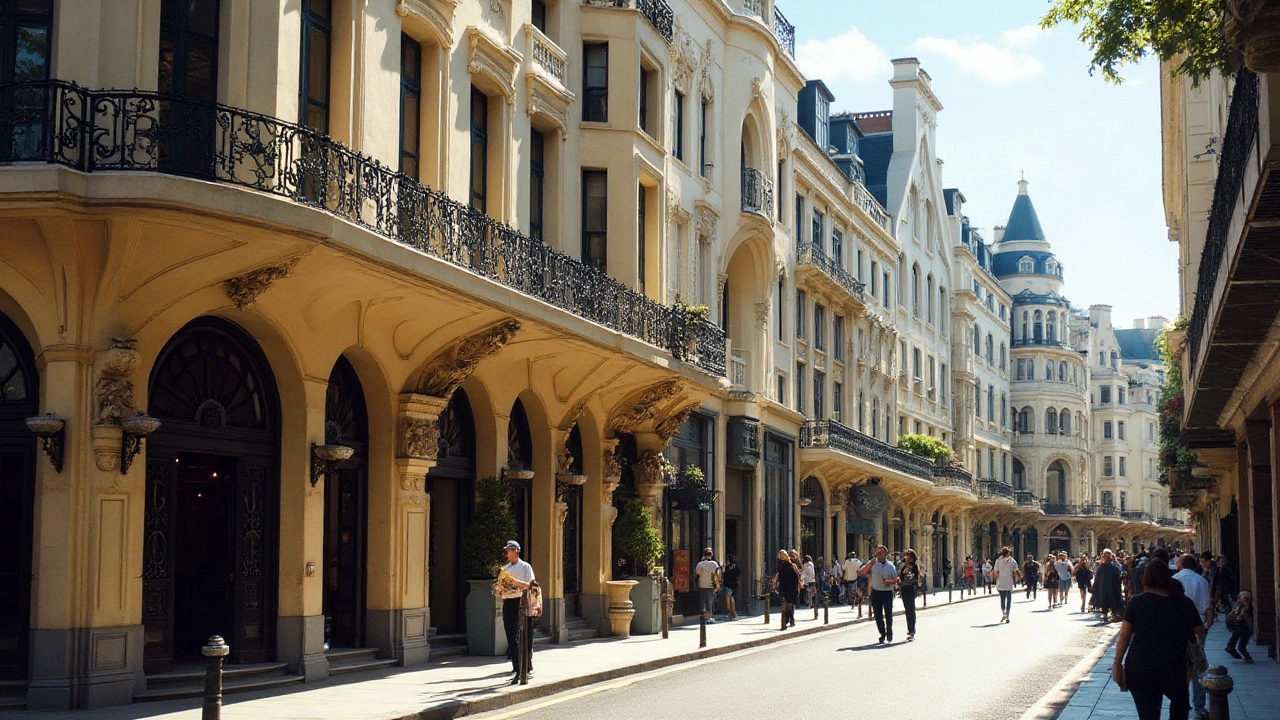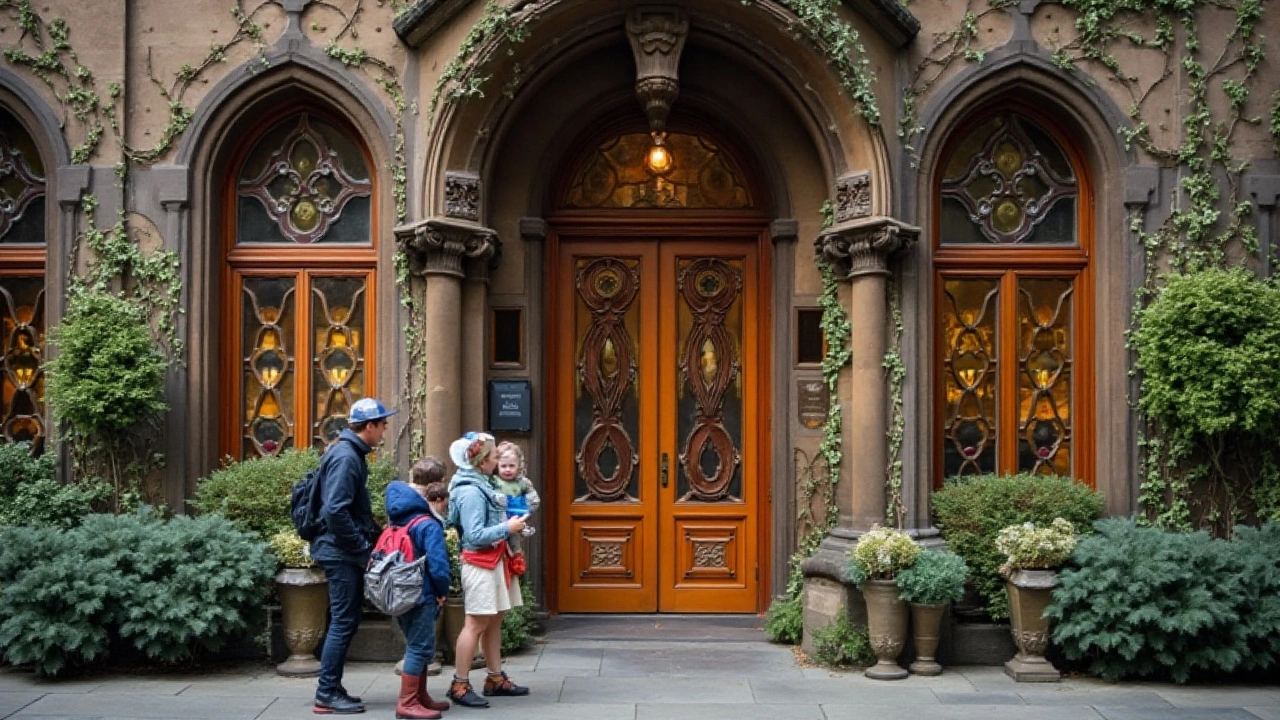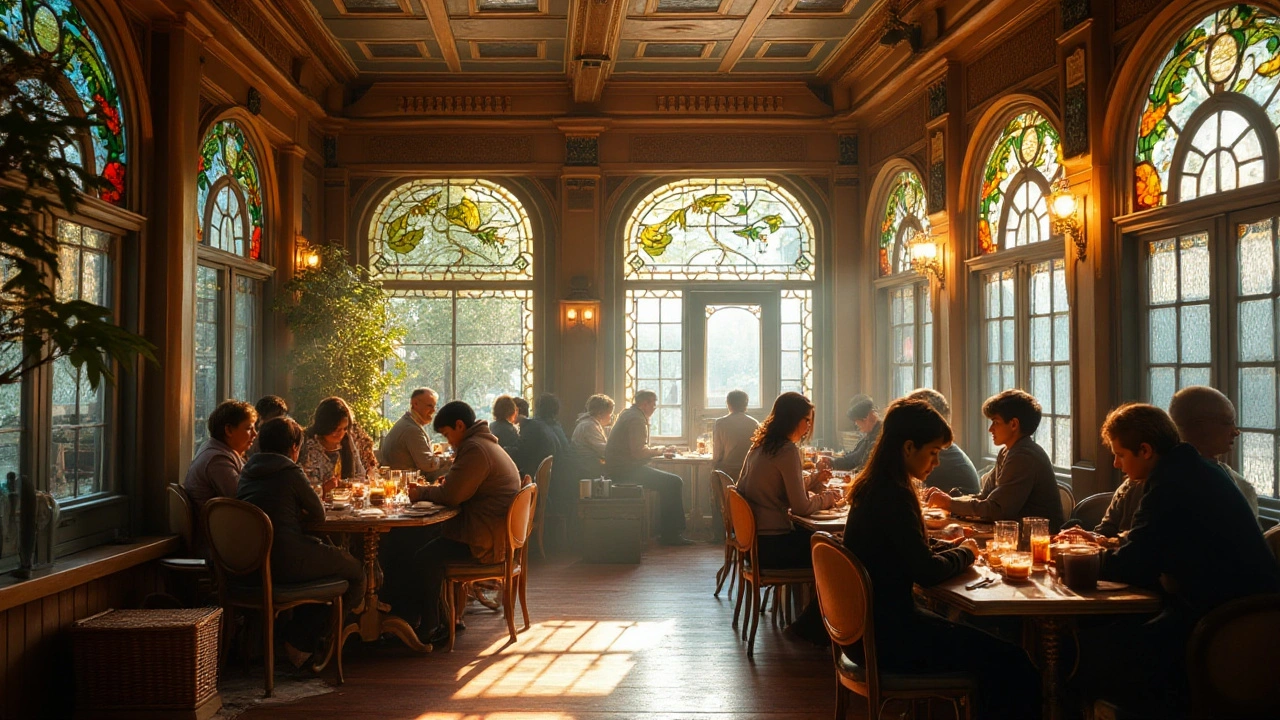Exploring the Timeless Appeal of Art Nouveau Architecture
 Aug, 26 2024
Aug, 26 2024
Art Nouveau, a French term meaning 'new art,' is more than just a historic architectural style; it's a celebration of creativity and innovation that peaked from the late 19th to early 20th century. Known for its sinuous lines, floral motifs, and elegant forms, Art Nouveau sought to break free from traditional architectural designs by embracing a more organic and holistic approach.
A key aspect of Art Nouveau's charm lies in its ability to harmoniously blend beauty with function. From intricately designed façades to the delicate details inside, buildings from this era invite observers to appreciate the harmony between structure and decoration. It’s this unity that makes Art Nouveau architecture stand out.
- The Origins of Art Nouveau
- Key Characteristics of Art Nouveau Architecture
- Notable Art Nouveau Buildings
- The Influence of Nature in Art Nouveau
- The Legacy and Modern Relevance of Art Nouveau
The Origins of Art Nouveau
Art Nouveau emerged as a reaction against the academic art, eclecticism, and historicism of 19th-century architecture. Influences came from the Arts and Crafts movement in England, which emphasized handcraftsmanship over industrial production. One of the primary catalysts in the rise of Art Nouveau was the need to establish a new visual language that resonated with the modern world.
This architectural style first took root in the 1890s and gained significant traction at the Exposition Universelle held in Paris in 1900. Art Nouveau’s reach extended across Europe and into the United States, with vital 'schools' developing in various regions. Belgian architects like Victor Horta and Henry van de Velde were key figures in the style’s early development, contributing to its vibrant growth. Horta, in particular, is renowned for his groundbreaking Hôtel Tassel in Brussels, one of the earliest examples of Art Nouveau architecture.
French architect Hector Guimard was essential in popularizing Art Nouveau in France. His designs for the entrances of the Paris Métro, with their sinuous, nature-inspired forms, stand as some of the most iconic representations of the style. Spain, too, saw its share of this movement, with Antoni Gaudí’s works in Barcelona, such as Casa Batlló and the more organic architectural forms of La Sagrada Familia, showcasing unique interpretations of Art Nouveau.
"Art Nouveau within Belgium, represented by Victor Horta, goes beyond pure structural art. It’s a merge between decoration and functionality, taking architecture into the realm of organic flow." - La Gazette des Beaux-ArtsCentral to Art Nouveau’s philosophy was the idea that art and everyday life are deeply interconnected. As a result, architects and designers sought to infuse their works with both aesthetic beauty and practical functionality. The movement took inspiration from nature, often incorporating plant-based motifs, intricate lines, and organic forms. This connection to nature was not just superficial but sought to create a dialogue between the built environment and the natural world.
The style also drew from various historical influences, ranging from ancient Celtic art to Japanese woodblock prints, forming a truly eclectic and global aesthetic. These influences helped Art Nouveau carve out its own identity, one that stood apart from the classical and neoclassical styles that dominated European architecture. As such, Art Nouveau created a new narrative space where architecture was not just about function but about invoking emotion and interaction.
Key Characteristics of Art Nouveau Architecture
One of the most captivating aspects of Art Nouveau architecture is its commitment to organic and flowing forms inspired by nature. Buildings in this style often feature delicate floral details, curving lines, and motifs that mimic the natural world. The aim was to create structures that felt alive and integrated seamlessly with their surroundings. This approach was a sharp contrast to the neoclassical and Gothic Revival styles, which focused more on rigid lines and historical themes.
The use of new materials was also pivotal in Art Nouveau's development. Iron and glass, often adorned with intricate wrought-iron designs or stained glass windows, became popular for their versatility and strength. These elements allowed architects to push the boundaries of what buildings could look like and how they were constructed. One exemplary figure in this movement, Antoni Gaudí, used these materials masterfully in his designs, like the well-known Casa Batlló and Sagrada Familia in Barcelona. Gaudí's works are often described as being more like living organisms than static buildings.
Color also plays a significant role in Art Nouveau architecture. Vibrant and varied hues can be seen in the tiles, stained glass, and painted motifs that decorate these buildings. This use of color was both aesthetic and symbolic, often aiming to evoke a specific mood or atmosphere. Austrian artist Gustav Klimt's work on the Secession Building in Vienna beautifully showcases this aspect, his mural "Beethoven Frieze" being a notable example of symbolic use of color and line in a large-scale architectural context.
Attention to detail is another hallmark of Art Nouveau architecture. Every element, from door handles to lighting fixtures, is thoughtfully designed to maintain the style's overall aesthetic. This holistic approach ensures that the interior and exterior of a building are harmonious. Charles Rennie Mackintosh, a Scottish architect, and designer, exemplified this trait with his Hill House in Helensburgh, Scotland. Each piece of furniture and every decorative element inside the house was crafted to complement its architectural style, creating a cohesive and immersive experience for the inhabitants.
The influence of Art Nouveau extended beyond Europe, reaching cities like Chicago and New York. In the United States, Louis Sullivan was a key proponent of this style. He embraced the belief that form should follow function, creating buildings that were not only beautiful but also practical. Sullivan's work on the Carson, Pirie, Scott and Company Building in Chicago demonstrates this principle. The intricate ironwork on the façade serves both decorative and supportive roles, emphasizing the perfect marriage of art and utility.
"Nature is the teacher," wrote architect and designer Hector Guimard. "Art must be the pupil." Guimard's designs, including the iconic Paris Metro entrances, reflect this philosophy. His works are characterized by fluid lines and botanical motifs that transport commuters into a world of natural elegance every time they enter the subway system.
Such focus on natural elements, color, new materials, and comprehensive design has ensured the enduring popularity of Art Nouveau. The style symbolizes a bridge between the old and the new, tradition and innovation. By understanding its key characteristics, we can better appreciate why it holds such a special place in architectural history and continues to influence modern design.

Notable Art Nouveau Buildings
The world of Art Nouveau architecture is adorned with a myriad of stunning buildings that each tell their own unique story. One of the most iconic is the House of Gaudí in Barcelona, also known as Casa Batlló. The undulating façade, with its dragon-like scales and bone-like balconies, is a testament to Antoni Gaudí's unparalleled creativity. He seamlessly blended art and architecture to create a space that feels almost alive.
Another remarkable example is the Hotel Tassel in Brussels, designed by Victor Horta. Completed in 1894, this building is often considered one of the earliest true Art Nouveau structures. Horta's use of intricate ironwork, stained glass, and organic forms within both the interior and exterior design set a benchmark for the style. The flowing lines and detailed ornamental work in this building continue to attract architecture enthusiasts from all over the globe.
Prague, another city rich in Art Nouveau heritage, boasts the Municipal House. This building, featuring a mosaic façade and a lavishly decorated interior, offers a glimpse into the opulent side of the period. Designed by Osvald Polívka and Antonín Balšánek, its impressive scale and intricate detailing make it one of the standout examples of this architectural style.
In Riga, Latvia, one can find over 700 Art Nouveau buildings, making it a treasure trove for lovers of this style. A notable mention is the building on Alberta Street by Mikhail Eisenstein. Its ornamental façade brims with sculptures, masks, and stylized floral patterns that capture the essence of Art Nouveau. Riga's abundance of these structures showcases how the style transcended borders and influenced designers across Europe.
Vienna's Secession Building, designed by Joseph Maria Olbrich, is another iconic piece. The building itself is a symbol of the artistic movement in Austria and represents the break from historicism. The dome, covered in golden laurel leaves, and the intricate frescoes inside exemplify the flourishing of new artistic ideals during this period.
With its graceful curves and natural motifs, the Van Eetvelde House in Brussels also stands out. Commissioned by Edmond Van Eetvelde and designed by Victor Horta, the house is a masterclass in how light and space can be manipulated to create an awe-inspiring living environment. Its glass and steel structure, paired with organic decoration, showcase the innovative use of materials characteristic of Art Nouveau.
Art historian Nikolaus Pevsner once remarked, "Art Nouveau is the first movement to reject historical styles completely and to employ organic, flowing lines and a naturalistic approach."These examples demonstrate the enduring charm of Art Nouveau architecture. By visiting these remarkable buildings, one can appreciate the spirit of innovation and creativity that defined this influential era.
The Influence of Nature in Art Nouveau
Nature's touch reverberates throughout the world of Art Nouveau, crafting a seamless bond between the natural world and architectural design. This unique movement, which embraced elements of flora and fauna, aimed to create spaces that felt alive and in harmony with the environment. Taking inspiration from the intricate curves of vines, the elegance of flowers, and the fluidity of water, Art Nouveau architects brought natural motifs into urban settings, making cities bloom with artistic flair.
One of the most recognizable aspects of Art Nouveau is its use of organic forms. Architects like Antoni Gaudí and Hector Guimard employed wavy lines and plant-like shapes in their buildings. Gaudí’s masterpiece, La Sagrada Familia in Barcelona, incorporates tree-like columns and branching structures that mirror the forms found in nature. Guimard, on the other hand, is celebrated for his Parisian Metro entrances which resemble the tendrils and blossoms of plants.
Another hallmark of the style is the use of natural materials. Stone, wood, and iron were often used to reflect the textures and forms of the natural world. This connection to nature wasn't just about aesthetics; it also represented a philosophy. The Art Nouveau movement believed in the unity of art and life, where nature could be a crucial bridge. In the words of Victor Horta, a leading figure in the movement:
“In nature, the line is the expression of life. It is life itself.”
The color palette also played a significant role. Soft hues of greens, browns, and blues were typically employed to evoke feelings of being in the natural world, even within urban environments. These colors, often found in stained glass windows and ceramic tiles, provided an ethereal glow that changed throughout the day, much like sunlight filtering through leaves.
One cannot talk about Art Nouveau without mentioning the influence of botanical illustrations. The detailed study of plants and their structures influenced the decorative details found in everything from iron railings to tile patterns. Artists like Alphonse Mucha, known for his iconic posters, used intricate floral designs both in his graphic work and architectural commissions. These elements added a level of detail and ornamentation that felt personal and intimate, bringing the beauty of the natural world into everyday life.
Interestingly, the movement wasn't confined to Europe. Art Nouveau also found expression in the United States, with architects like Louis Sullivan incorporating organic motifs in his skyscraper designs. In Japan, the style was embraced in various ways, blending with traditional Japanese art forms to create a unique fusion. This global reach underscores the universal appeal of incorporating natural elements into architecture and design.
Overall, the enduring charm of Art Nouveau lies in its celebration of nature. By looking to the natural world for inspiration, architects and artists of the period created spaces that were not only beautiful but also resonant with the life and energy of the world around us. This holistic approach is part of why Art Nouveau remains so captivating even today.

The Legacy and Modern Relevance of Art Nouveau
Art Nouveau may have had its heyday over a century ago, but its influence is far from a fading echo. The enduring appeal of this architectural style lies in its unique ability to blend the old with the new, offering something timeless and yet strikingly innovative. As trends come and go, the Art Nouveau aesthetic continues to find admirers who are captivated by its whimsical yet carefully crafted designs.
One of the most compelling aspects of Art Nouveau is its seamless integration of nature into architectural elements. Buildings adorned with flowing lines, floral patterns, and organic shapes blur the boundary between structure and the natural world. This design philosophy has found renewed relevance in modern times, where sustainable architecture and biophilic designs are gaining traction. By emphasizing a connection with nature, Art Nouveau inspires contemporary architects to create spaces that promote well-being and sustainability.
The style's adaptability also contributes to its lasting charm. While classic Art Nouveau buildings like Antoni Gaudí’s Casa Batlló or Hector Guimard’s Parisian metro entrances are celebrated for their artistic originality, modern architects often draw from this historical source to create fresh, contemporary interpretations. These newer designs echo the sinuous lines and natural motifs of Art Nouveau while incorporating modern materials and technologies. This approach ensures that the principles of Art Nouveau remain relevant, allowing the style to evolve and adapt to today’s architectural landscape.
Art Nouveau's influence extends beyond architecture to various fields of design and art. In today’s digital age, graphic designers and illustrators frequently reference the style’s iconic elements. This can be seen in everything from website designs to marketing materials where the graceful lines and ornate details of Art Nouveau bring a touch of elegance and sophistication. The enduring popularity of Art Nouveau in contemporary design highlights its versatility and timeless appeal.
Data supports the ongoing interest in Art Nouveau. According to a 2023 survey by the Architectural Digest, 65% of respondents expressed admiration for historical architectural styles, with Art Nouveau being a significant favorite. This appreciation is not just academic; it translates into market value as well. Properties featuring Art Nouveau elements often fetch higher prices in the real estate market, reflecting a broader cultural appreciation for this distinctive style.
"Art Nouveau reminds us that architecture is not just about shelter. It’s about creating livable art," says renowned architectural historian, Dr. Emily Thompson.
The cultural impact of Art Nouveau extends to education as well. Many architecture and design schools now include Art Nouveau in their curricula, recognizing the importance of understanding its principles and techniques. Students are encouraged to study the works of past masters to inform their own innovative designs, bridging the gap between history and modernity.
In conclusion, the legacy of Art Nouveau is not confined to the annals of architectural history but continues to shape the present and future. Its blend of aesthetic beauty and functional design, its roots in nature, and its adaptability make Art Nouveau an enduring inspiration for architects and designers around the world. Whether in the preservation of historic buildings or the creation of new art and architecture, Art Nouveau remains a vibrant and influential force.